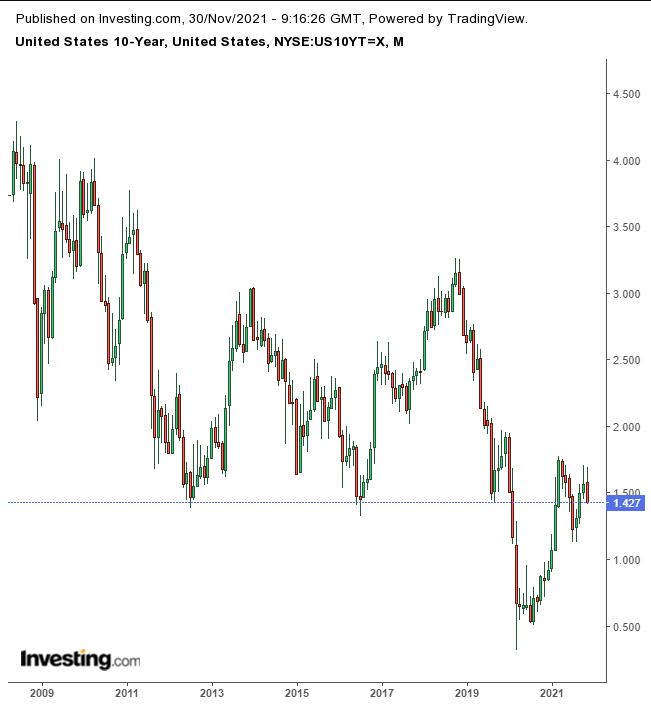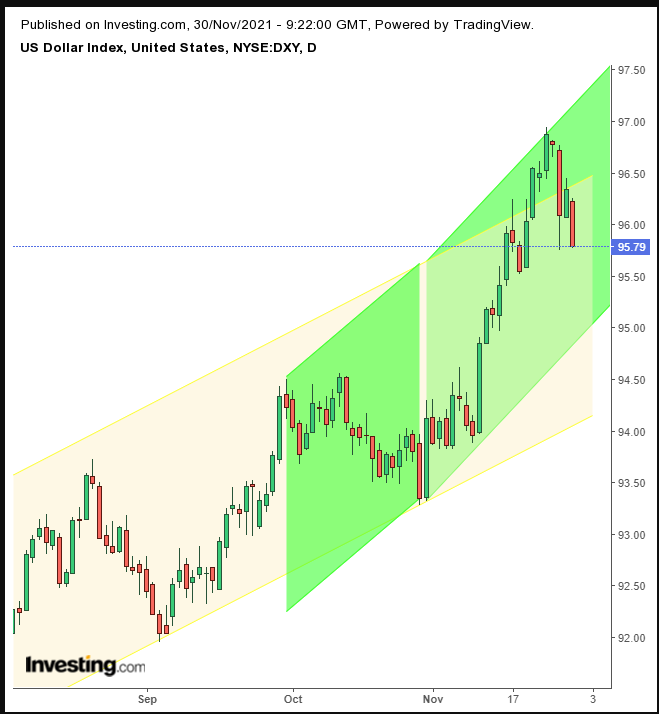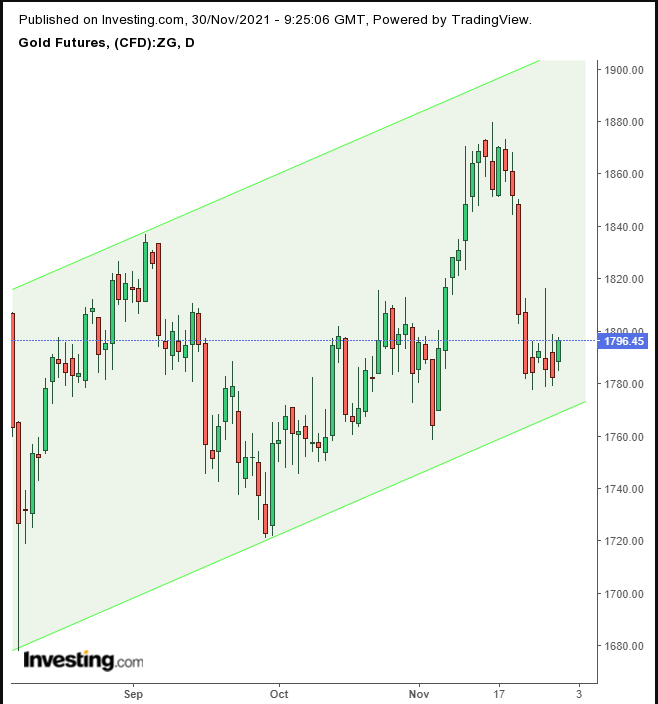- Moderna CEO warns on Omicron
- Powell may signal a delay on rate hikes
- Dollar slips
Key Events
The market narrative on the risk from the new variant of COVID-19 shifted yet again during Tuesday trading, provoking another global selloff with futures on the Dow, S&P, NASDAQ and Russell 2000 slumping. Ongoing uncertainty due to a lack of any concrete data on Omicron means that markets are expected to remain volatile.
Safe haven gold along with the Japanese yen continue to benefit from the uncertainty in markets.
Global Financial Affairs
Today provides another example in a long line of events proving market fickleness. On Friday, global equities sold off dramatically on reports that the Omicron variant could pose a severe risk to world health and global economies. Then, on Monday, that assessment was deemed premature as the South African researchers who originally identified the strain said Omicron symptoms were milder than the Delta variant. But investor sentiment has whipsawed back to risk-off after Moderna's (NASDAQ:MRNA) chief executive said earlier Tuesday that the mutation could pose a severe threat and a new vaccine may be needed.
Yesterday, Fed Chief Jerome Powell noted that Omicron poses risks to both sides of the central bank's mandate for stable prices and maximum employment. His remarks stoked speculation the spread of the new strain could delay interest rate hikes. Today Powell is expected to tell Congress that the new strain is another challenge facing the economy that is already enduring the worst inflation in three decades.
Some market watchers think that the US central bank may delay raising interest rates next year. While that view didn't seem to help equities, it boosted the price of gold and the yen and dented the dollar.
All four US futures were deeply in the red and the Russell 2000, which lists domestic firms that suffered most during the height of the pandemic, was the biggest loser, down over 1.5%. It was closely followed by futures on the blue-chip, mega-cap Dow Jones while contracts on the NASDAQ 100 were down a mere 0.5%. Technology shares excel even when the economy is slowing. They also benefited during previous coronavirus lockdowns when people were forced to work from home.
Sectors that require an open economy to thrive, including energy and travel, led the European STOXX 600 Index to a decline that wiped out Monday's rebound. Retail stocks also underperformed, as investors expected consumers to reduce spending.
Meanwhile, eurozone inflation for November reached its highest level on record, clouding the European Central Bank's policy path.
Stocks in Asia gave up early gains after the comments from Moderna management. Japan's Nikkei, which fell 1.63%, and Hong Kong's Hang Seng, which slid 1.58%, were hit the hardest. China's Shanghai Composite eked out a 0.03% gain.
US Treasuries fell even lower, dipping below Friday's slide when fears of the new mutation first hit markets.
Yields on the 10-year note are forming a top on the daily chart. The benchmark Treasury has become a barometer for COVID-19 fears.

Rates which already fell below the 200 DMA are now contesting the 100 DMA, forming the last support before Treasury yields top out. On the weekly chart, the yield movement since October may be developing the second top in a double top, resisted by the 200 WMA, with the 100 WMA forming a natural neckline. On the monthly chart, where it's clear the current levels have been supported in 2012 and 2016—we might be experiencing support that turns into resistance.
The dollar fell as investors shifted funds to traditional safe haven assets, the yen, the Swiss franc and gold. Nevertheless, traders should note that after the 2008 crash, the greenback was the safest haven.

The USD may return to the bottom of its rising channel.
Gold climbed to a weekly high on the back of the weakening dollar.

In a mirror image of the US currency, the yellow metal may rebound off the bottom of its rising channel as it takes on the high 1,800 levels, where it peaked out in mid-November.
Bitcoin is marginally higher after a three-day advance when risks about the new variant were downplayed.

The digital coin has been struggling between bulls and bears on a potentially crucial level. It appears that traders are waiting for a clear picture on the severity of Omicron before choosing whether to buy or sell.
Oil tumbled on the more pessimistic view for demand. The energy commodity is on the verge of a bear market, having posted a 20.74% slide.
However, an official bear market requires a 20% decline on a closing basis; as of now, the price is only 19.65% from its Oct. 26 peak. Oil traders will also be closely watching the upcoming OPEC meeting on Thursday to see whether the group will delay its planned increase in supply in an attempt to protect the price.

WTI fell to the lowest since Aug. 26, as it crossed below the 200 DMA for the second time since Friday. However, the time might not be suitable for a short, as the RSI shows that oversold conditions have reached their worst point since September 2020, and the price may bounce off a slow-rising trendline since March.
The same trendline might prove to be the neckline of a top, but after a 19% drop in less than three weeks, a bounce is more likely than a continued straight decline.
Up Ahead
- China publishes Caixin Manufacturing PMI on Wednesday.
- On Wednesday, Eurozone Manufacturing PMI is published.
- US ISM Manufacturing PMI is released on Wednesday.
Market Moves
Stocks
- The STOXX 600 fell 1%
- Futures on the S&P 500 fell 0.9%
- Futures on the NASDAQ 100 fell 0.4%
- Futures on the Dow Jones Industrial Average fell 1.2%
- The MSCI Asia Pacific Index fell 0.6%
- The MSCI Emerging Markets Index fell 0.4%
Currencies
- The Dollar Index fell 0.2%
- The euro rose 0.4% to $1.1338
- The Japanese yen rose 0.3% to 113.14 per dollar
- The offshore yuan rose 0.2% to 6.3742 per dollar
- The British pound rose 0.2% to $1.3336
Bonds
- The yield on 10-year Treasuries declined five basis points to 1.45%
- Germany's 10-year yield fell two basis points to -0.33%
- Britain's 10-year yield fell four basis points to 0.82%
Commodities
- Brent crude fell 2.7% to $71.46 a barrel
- WTI crude fell 2.75% to $68.02 a barrel
- Spot gold rose 0.5% to $1,793.90 an ounce
